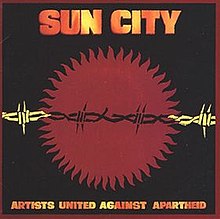Sun City (album)
| Sun City | |
|---|---|
 |
|
| Studio album by Artists United Against Apartheid | |
| Released | December 7, 1985 |
| Recorded | 1985 |
| Genre | various |
| Length | 45:33 |
| Label | EMI Manhattan Records |
| Producer |
Steven Van Zandt Arthur Baker |
| Professional ratings | |
|---|---|
| Review scores | |
| Source | Rating |
| Allmusic |
|
| Rolling Stone | Not rated link |
Sun City was a 1985 album that contained several versions of the Steven Van Zandt-led Artists United Against Apartheid's "Sun City" protest song against apartheid in South Africa as well as other selections in the same vein from that project.
In addition to the title track, a number of other songs were recorded at the time, completing an album's worth of material. Drummer-musician Keith LeBlanc and journalist Danny Schechter came up with "Revolutionary Situation", an audio-collage set to music that took its title from the words of South Africa's then-interior minister Louis Nel condemning the state of the country. Amid a background of yapping police dogs, sounds of mayhem and revolt in the township, LeBlanc and Schechter mixed in angry declarations by activists like Alan Boesak, Bishop Desmond Tutu and Nelson Mandela's daughter Zindzi, looped with what was at that time the most recent interview with her father, recorded in 1961.
Inspired by his meetings with several of other artists who volunteered, Bono of U2 went back to his hotel room and wrote the song "Silver and Gold" the same evening. The song was quickly recorded for inclusion on the compilation, with Keith Richards and Ron Wood of The Rolling Stones accompanying him. Ron Wood's guitar work is notable for using Keith's switchblade as a slide. "Silver and Gold" was also distributed separately as a promotional single. Because the song was quickly recorded for inclusion on the compilation, it was initially left off the track listings on the original 1985 album and cassette pressings and it was considered to be a hidden track. Bono later explained the reasons for this in an appearance on the US syndicated radio show "Rockline" with Bob Coburn that the reason why it did not appear on the track listings was because he submitted the tape for the song after the album's artwork had already been printed by EMI Manhattan Records. When Razor and Tie reissued the album in 1993, the song was included on the track listings. U2 also recorded two versions of the song: a live version released in the Rattle and Hum film and album and a studio version as B-side to "Where the Streets Have No Name".
...
Wikipedia
